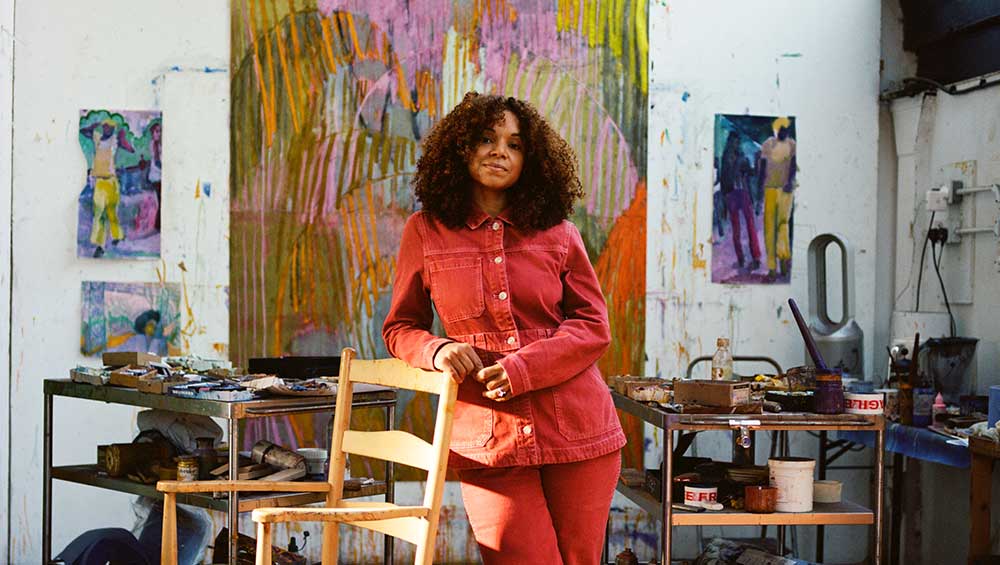
Christina Kimeze in her studio, 2024. Photo: Lily Bertrand-Webb. Courtesy the artist and Hauser & Wirth.
by VERONICA SIMPSON
Fed up with London’s drab and dreary wintry streets? Tropical heat awaits you in Peckham. The South London Gallery has become a portal to landscapes of searing colour, thanks to Christina Kimeze. The retina-blast of yellows, oranges, saffron and ochre are so intense that my camera phone refuses to acknowledge the true hues of her work and dials them down in tone. But true they are, true to the visceral intensity with which Kimeze appears to see the world – or at least render it for our eyes.
But these are not landscapes, and this is not Uganda she is showing us – unlike Something Other Than the World Might Know, her solo exhibition at the White Cube Paris in 2023, in which she depicted plants and places inspired by a trip to her father’s homeland. This is Kimeze translating emotion and energy, potential and movement, rendering the ungraspable, but very tangible spaces between and around people and bringing her own feelings, interpretations and memories into the mix. But whether the palette is warm with mango, saffron and lime, or a more nighttime palette of blues, purples and lilacs, it engenders a feeling of yearning – an internal, emotional response to an idea (or ideal) of elsewhere. Part of what makes her work so vivid and evocative are the strong, gestural strokes with which she inscribes her pastels and chalks into the unusual, furred texture of the suede matboard that has become a trademark material. At times, the characters and spaces are almost holographic – such as the figure in Soaring III (2024), whose darkly shaded eyes appear to be emerging from the fabric into the room.
,-2024.jpg)
Christina Kimeze. Soaring (III), 2024. Oil, pastel and oil stick on suede matboard, 210 x 165 cm. © Christina Kimeze, image courtesy of the artist. Photo: Matthew Hollow.
Where the Paris show was a celebration of quietness and interiority – in each, a solitary female figure experiencing stillness – the South London Gallery show is all ebb and flow, community and connection. Called Between Wood and Wheel (a quote taken from Night at the Roller Palace, a poem by January Gill O’Neil), these works speak of communion: with friends and family and also with the burgeoning Black roller-skating movement that Kimeze has found in London and the US. Film as well as literature often inspires her work, and some of the works on paper on show in the Fire Station gallery, across the busy Peckham Road from the main building, were based on film stills from the 1980s documentary Get Rollin’. But female characters, real and imagined – including folkloric and mythical female figures, from witches to goddesses – predominate.

Installation view, Christina Kimeze: Between Wood and Wheel, 2025, South London Gallery. Photo: Andy Stagg.
Kimeze has talked of her intention to represent “the idea of existing between two emotional spaces and the feelings of ‘otherness’ that can arise from this space”. Inner lives and outer lives are enmeshed and translated via her unique palette and eye for pattern.
Kimeze’s focus on art is relatively recent. She did a degree in biological sciences at the University of Oxford, before enrolling on the Royal Drawing School’s postgraduate programme, where she received the 2022-23 Sir Denis Mahon award. Her inspirations draw heavily on literature and black feminist writers. Her Paris paintings were influenced by Gwendolyn Brooks’ 1953 novel Maud Martha.
Recent exhibitions include the groups shows: Women & Freud: Patients, Pioneers, Artists at the Freud Museum, London (2024); Drawing Biennial 2024 at the Drawing Room (2024); Soulscapes at the Dulwich Picture Gallery (2024); Present Tense at Hauser and Wirth, Bruton (2024); Interior at the Michael Werner Gallery, London (2023); and the Great Women Artists IV, Residency at Palazzo Monti, Brescia, Italy (2022).
Kimeze talked to Studio International by email.
Veronica Simpson: The work you showed in Paris in 2023 was all about stillness, but these new works for the South London Gallery (SLG) are about movement and freedom. How did that evolution or exploration progress, and what inspired it?
Christina Kimeze: Some of the ideas I remain most interested in deal with “quiet”. Kevin Quashie’s writing was a great source of inspiration for bringing the concept of quiet to life, as a place to dream and realise possibilities and as sites of change. The idea of movement started to come into the work with motifs such as the spiral staircase to navigate the space. Routes around these more internalised emotional spaces have always been something I’ve been interested in – particularly if it’s convoluted, not linear and difficult to follow. I love Louise Bourgeois’ spiral works and the notion of the direction – either going into the centre or spiralling out – being important.
VS: I liked the ideas your earlier work articulated of stillness, solitariness and introspection as something to be claimed and celebrated. Is it too simplistic to think there is an evolutionary relationship: from fully occupying your own space in stillness to a movement that then emerges that is freer – a question of choice rather than propulsion by outside forces?
CK: Yes, I love that too. I also enjoy that idea of having agency in occupying that space. That’s often central in my work, and I try to play with that, either through elongating the body or playing with perspective or the vantage point of the figure looking down on us, for example.
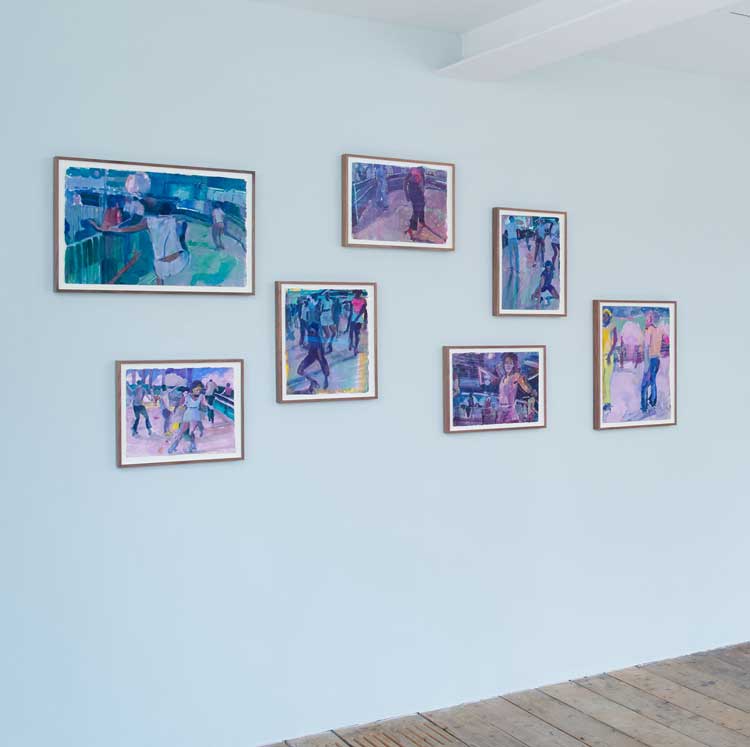
Christina Kimeze. Roller Skaters, installation view, Christina Kimeze: Between Wood and Wheel, 2025, South London Gallery. Photo: Andy Stagg.
VS: I would love to hear more about how the resurgent popularity of roller-skating in London’s Black community has inspired you – I love seeing people gliding around in my area of south London, Crystal Palace and Sydenham. What does this individual and unconstrained movement represent? And are you a skater?
CK: To pick up on your last point about fully occupying your own space of stillness, I think that’s relevant here and something I became fixated on, and how to express that (stillness). I became fixated on motifs that might help me flesh out a more dynamic way of exploring these spaces of introspection, and roller-skating, which is something I’ve always loved, became a way of visualising this for me.
Once I started looking into these ideas, I started seeing people on skates everywhere and it snowballed from there. I was also introduced to some contemporary film-makers documenting the scene, as well as some classic films.
I love your description of roller-skaters gliding. Flying, soaring: the parallels with flight are apparent and that led me to precious folkloric accounts and stories of women and communities who fly. Magical flight: the body stays on the ground as the soul soars … stories of absconded slaves flying back home to west Africa from the plantations. These are sacred stories, and I felt great responsibility even touching on these ideas in my work. The ideas are powerful and sacred and had to be handled with care.
It’s also not just freedom in terms of the subject, but also experimentation with surface, texture, materials.
VS: You have established an unusual technique of using chalks and pastels on suede, which works very powerfully to conjure an immersive kind of blurring and sensuality, of being in the moment. What techniques are you enjoying using for this show? And how does the subject matter influence your choice of material?
CK: The work was always, and continues to be, experimental and absolutely the evolution of using the suede matboard, a cousin of velvet, was driven by the subject and wanting to have a sense of the ungraspable, in between moments. I always think I’m just about done with the surface and then find it has something more to give. I work on paper and canvas and aluminium as well, usually engineering a more slippery surface as a counterpoint to the suede works, which are absorbent and so slow me down. I find having both ways of working on the go at once to be satisfying in some way.
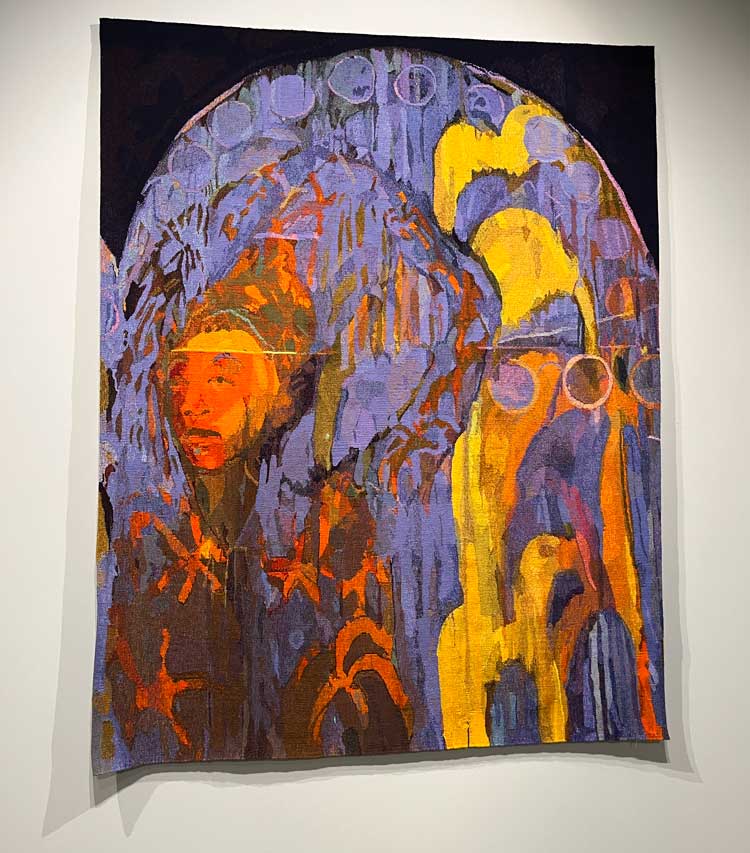
Christina Kimeze. Tapestry made in collaboration with Edinburgh’s Dovecot Studios. Installation view, Christina Kimeze: Between Wood and Wheel, 2025, South London Gallery. Courtesy the artist and ABCollection. Photo: Veronica Simpson.
VS: I loved the tapestry that you made in collaboration with Edinburgh’s Dovecot Studios for this show. The authenticity with which Dovecot rendered your palette and style is remarkable. How did that come about?
CK: I was interested in how the specifics of the surfaces of my work would translate to tapestry as a medium and Margot Heller [director of the South London Gallery] introduced me to Dovecot Studios. I had recently been shortlisted for a tapestry commission with another studio, so it felt like this idea was meant to happen. The weavers at Dovecot are extraordinary, as is the process.
VS. How do you translate your palette from the personal to the universal? There is such an individual, expressionistic power in depicting, say, a woman floating on a purple lilo on a purple river (as in one of your earlier paintings), but does it require a shift or recalibration of your palette to communicate something more universal?
CK: You can’t get away from colour being a personal thing. I think colour is relational: our relationship to a particular colour changes depending on what other colours sits alongside it, and the scale and the medium also play a huge part. Some of these concepts are universal and some aren’t. All these elements can be profoundly affecting. It makes me think of William Nicholson’s Miss Simpson’s Boots (1919), a painting of shoes that I’ve always been so deeply moved by with its specific combination of the pale violet and cadmium red. It’s also a sublime painting. I don’t know what is universal about that, and I wouldn’t want to make any grand conclusions about my own colour choices in my work, but it’s a fascinating question.
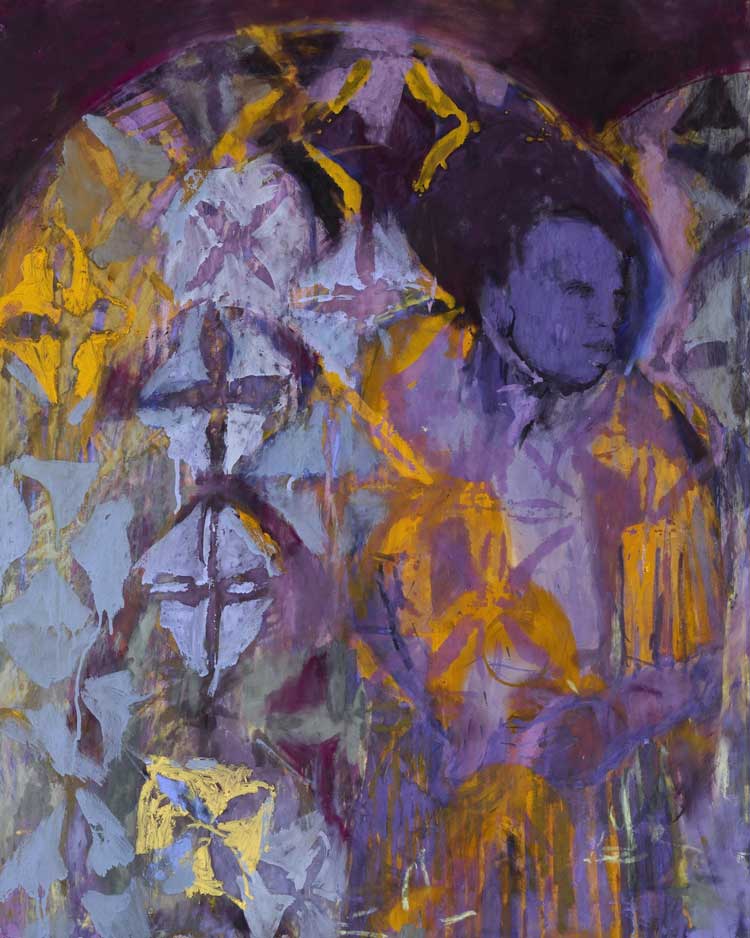
Christina Kimeze. Arches, 2024. Oil, pastel and oil stick on suede matboard, 110 x 90 cm. © Christina Kimeze, image courtesy of the artist. Photo: Matthew Hollow.
VS: What role does architecture play in your work? There is, for example, a strong repetitive motif of arches. And in the SLG show, there is a kind of blended choreography – people’s raised arms become arches, as if the whole space is an expression of joy or uplift.
CK: The motifs in my work are often taken from architecture, including western architecture and interiors, but the arches in particular also relate to the foliage and arched shape of banana leaves that recur in my work. That is a specific reference to the matoke fruits of Uganda and a very personal link. Formally, the arches often give my paintings structure, which I like as a counterpoint to the sometimes more expressive mark-making. It also references some of the “heartlands” painters who I will always look to.
VS: You have talked of your acute sense of insider/outsider awareness. Does putting these emotions and experiences into art help you to process the relevant feelings?
CK: I think that “in between” feeling is something I’m trying to get into with my work – the leaden and the airborne, the enduring qualities of wood and the moving, shifting qualities of the wheel. Sometimes, it’s easier to look at these more formally and simply with shape, such as arches, circles and lines, and then sometimes it’s something more ungraspable. And I’m trying to achieve both in my work.
,-2024.jpg)
Christina Kimeze. Soaring (I), 2024. Oil, pastel and oil stick on suede matboard, 210 x 165 cm. © Christina Kimeze, image courtesy of the artist. Photo: Matthew Hollow.
VS: I’m intrigued by your original field of study, biological sciences, and how that might inform your work. What inspired your shift towards art, and do you feel it is a move away from science, or do you think that your understanding of our biological selves gives you extra power in rendering your emotional self?
CK: When I was at Oxford, I studied biology. My finals focused on plants and the environment, and I see this coming through in the work, along with some more emotional ideas. But I also think the experimentation with materials and surfaces, and the alchemy in it, probably stems from spending a lot of time in the lab. That being said, I have a distinct memory of missing tutorials and deadlines to attend life drawing classes in the Jericho Tavern or to go out drawing. Can you imagine?!
I’ve always had a commitment to making artwork. I don’t know where it came from, although my great-aunt (whom I never met) was an artist and I grew up with some of her very formal drawings of birds and cathedrals etc around the house. No one else in my family makes art or works in a creative field. But I just was always into it. When I was a kid, I remember my drawings making the cover of the school magazine, and I suppose I knew that I could draw and paint and I loved it, so I kept doing it, trying to improve and find something in it. Through all the different jobs I’ve done, making art has honestly been the only consistent thing in my life – so it wasn’t so much a shift but more a refocusing and dropping all the distractions, ie jobs and focusing on making work and building a practice. That’s where the Drawing School came in. I don’t know about biology giving me any more insight, but I think detours in life are good and bring a different perspective to the work.
VS: Do share your insights and experience from being at the Royal Drawing School – a most unusual institution. How did the teaching and the community help you develop your artistic voice and vision?
CK: The Drawing School was transformative for me because it gave me the opportunity to build a practice by focusing completely on making work all day, every day without the interruptions of having to work every day to fund my practice – as all the places are scholarships and you get a free studio space. I loved it.
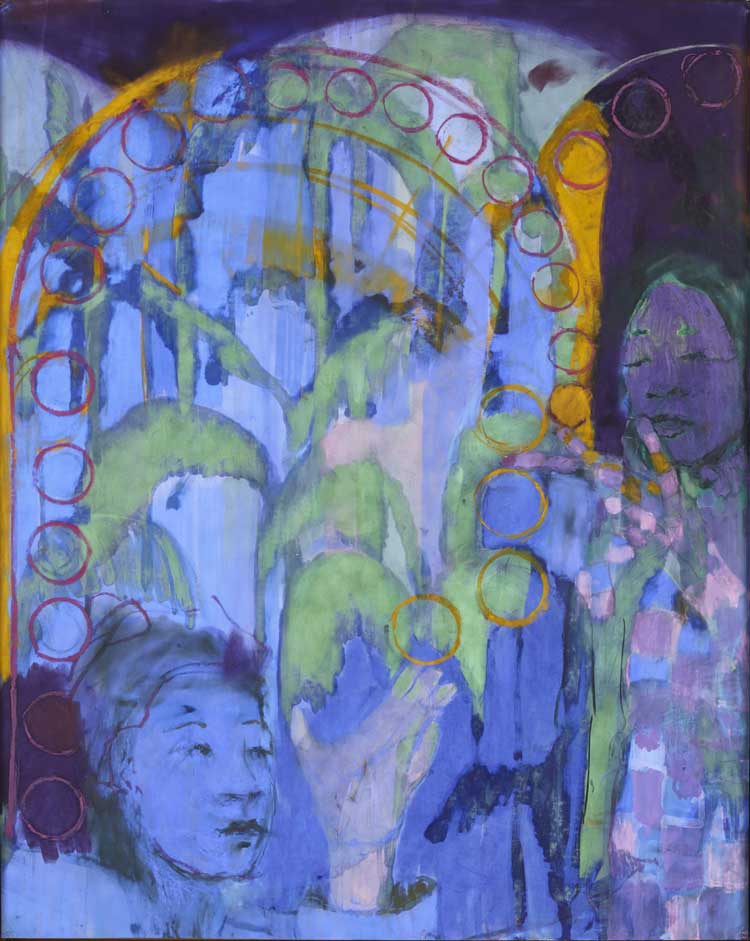
Christina Kimeze. Screen (I), 2024. Oil, pastel and oil stick on suede matboard, 110 x 90 cm. © Christina Kimeze, image courtesy of the artist. Photo: Matthew Hollow.
VS: In a short essay for the above institution, you said you were looking forward to setting up a studio with your fellow students in London. Has this happened? And how are you enjoying the experience of being an artist, with all the precarity that entails, in this stimulating but challenging city? Could you imagine living and working anywhere else?
CK: I’m London born and bred so it is hard to imagine being anywhere else. Good studio space is hard to find though, and there are a lot of studio providers out there providing inadequate space for artists at exploitative prices – poor light, ventilation etc. I was lucky and managed to find a daylight studio, which was transformative for my work as I use only natural light all day with light flooding in through north-facing skylights and wraparound windows. There are some basics missing though and I still have no sink, hot water or heating. I’m finally moving to a bigger, more hospitable space this year but, tough as the winters were there, I will miss that space!
VS: You seem to be an avid reader, with literature and philosophy often underpinning ideas and titles. Can you give us some recommendations from your current reading?
CK: I’m reading Olivia Laing’s book The Garden Against Time, which deals with ideas of gardens as paradise and the political, who gets to have a garden, and who doesn’t. I’m interested in the garden as a concept.
I’ve also been enjoying The Ink Dark Moon, a collection of Haiku poems by Izumi Shikibu and Ono no Komachi about love and longing.
• Christina Kimeze: Between Wood and Wheel is at the South London Gallery until 11 May 2025.